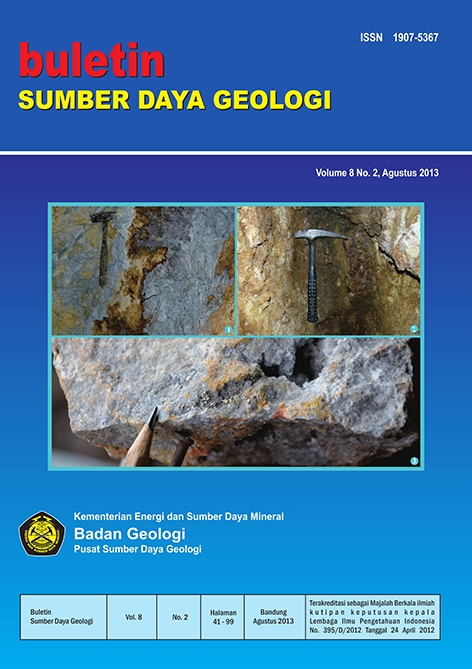STUDI ALTERASI DAN MINERALISASI DISEKITAR GUNUNG AGUNG, KABUPATEN KULONPROGO – PURWOREJO
Abstract
Daerah Gunung Agung secara administratif termasuk dalam wilayah Kecamatan Kokap, Kabupaten Kulonprogo, Provinsi Daerah Istimewa Yogyakarta dan Kecamatan Bagelen,Kabupaten Purworejo, Provinsi Jawa Tengah. Secara regional termasuk dalam Pegunungan Kulonprogo yang di daerah ini dijumpai indikasi alterasi dan mineralisasi logam.Pengamatan lapangan dan pemercontohan diikuti dengan analisis petrografi, X-RD, kimia mineral dan inklusi fluida. Studi dilakukan untuk mengetahui proses dan posisi mineralisasi.
Mineralisasi yang berkembang umumnya berupa urat dan stock work silika-kuarsa yang diikuti pembentukan mineral ubahan lempung argilik disekitarnya, dengan intensitas lemah-sedang. Urat silika-kuarsa mempunyai ketebalan 10-30 cm, dengan kadar Au berkisar 50-2.608 ppb. Hasil analisis XRD dan petrografi dijumpai adanya asosiasi mineral kuarsa, pirit, barit, muskovit dan serisit. Hasil pengamatan dengan metoda inklusi fluida pada urat kuarsa menunjukan fasa tunggal dan ganda, umumnya mengalami necking dengan kandungan NaCl: 2,5 - 3,9 % berat, suhu homogenisasi antara 157 C hingga 225 C.
Proses alterasi terjadi dalam dua tahap, tahap pertama terjadi alterasi mesotermal pada suhu antara 280-340 C, sehingga mengubah mineral feldspar menjadi serisit dan asosiasi mineral sulfida. Tahap kedua, terjadi proses alterasi epitermal pada crustiform-colloform hingga kalsedonik superzone, suhu 175-230 C, yang menghasilkan asosiasi mineral barit, sulfida dan logam mulia.
Downloads
References
Asikin S., Handoyo, A., Pratistho, B., Gafoer, S., 1992, Geologi Lembar Banyumas, skala 1 : 100,000. Puslitbang Geologi, Bandung
Bemmelen, R.W., 1949. Geology of Indonesia. vol. IA, Martinus Nijhoff, the Hague, pp. 637-647.
Buchanan, L.J., 1981. Precious metal deposits associated with volcanic environments in the Southwest Arizona. Geological Society Digest, 14, p.237-262.
Budiadi E, 2008. Peranan Tektonik Dalam Mengontrol Geomorfologi Daerah Pegunungan Kulon Progo, Disertasi Doktor Ilmu Geologi, UNPAD, Bandung, Tidak dipublikasikan
Hedenquist J. W., White N. C., 1995, Ephitermal Gold Deposit : Style, Characteristics and Implication, Society of Economic Geologists, Newsleter no 23, p.1, 9 – 13.
Harjanto, A., 2008; Magmatisme dan Mineralisasi di Daerah Kulonprogo; Disertasi Doktor Teknik Geologi, ITB, Bandung, tidak dipublikasikan.
Soeria Atmaja R., Maury R.C., Bellon H., Pringgoprawiro H., Polve M., and Priadi B., 1994, “The Tertiary Magmatic Belt in Java” Journal of South East Asian Earth Sciences, Vol 9, No ½, p 13 – 27
Sutanto 2000. Batuan Vulkanik Daerah Kulon Progo, geokronologi dan geokimia, Buletin Tekmira Nomor 14 .
Rahardjo, W., Sukandarrumidi, & Rosidi, H.M.S. 1995. Peta Geologi Lembar Yogyakarta skala 1 : 100,000. Puslitbang Geologi, Bandung
Morrison, 1977, Important Hydrotermal Minerals and Their Significance, 7 ed, Kingston Morisson Ltd, New Zealand
Haas, J. L., Jr., 1971. The effect of salinity on the maximum thermal gradient of a hydrothermal system at hydrostatic pressure. Economic Geology 66, pp. 940-946
Copyright (c) 2018 Buletin Sumber Daya Geologi

This work is licensed under a Creative Commons Attribution-NonCommercial-ShareAlike 4.0 International License.
Authors whose manuscripts are published agree to the following terms:
The publication rights of all journal manuscript materials published on the Buletin Sumber Daya Geologi website are held by the editorial board with the knowledge of the author (moral rights remain with the manuscript’s author).
The formal legal provisions for access to digital articles in this electronic journal are subject to the terms of the Creative Commons Attribution-ShareAlike (CC BY-SA) license. This means that Buletin Sumber Daya Geologi has the right to store, convert media/formats, manage in the form of a database, maintain, and publish the article without requesting permission from the author, as long as the author’s name is cited as the copyright holder.
Manuscripts published in both print and electronic formats are open access for educational, research, investigative, and library purposes. Beyond these purposes, the editorial board is not responsible for any violations of copyright law.













